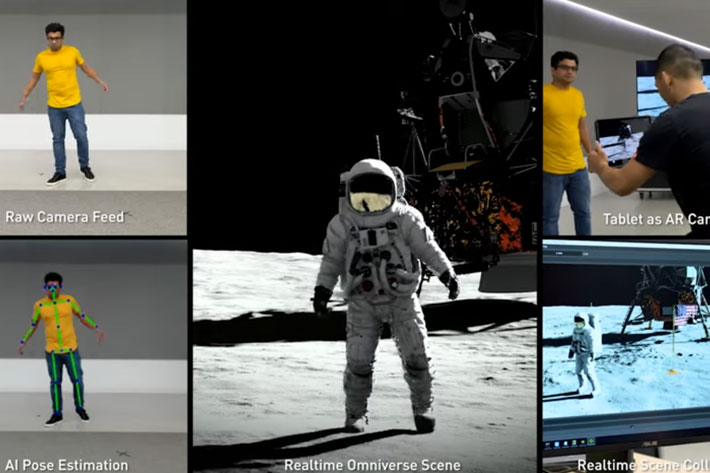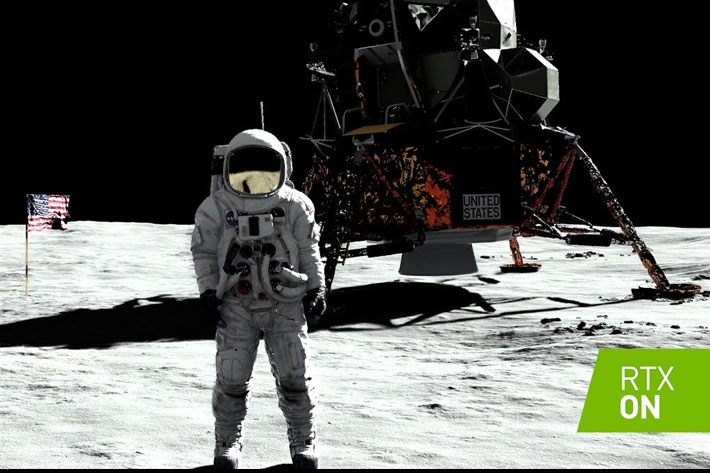
With NVIDIA’s demo of the Apollo 11 moon landing on display at SIGGRAPH 2019, everyone can walk on the moon just as Neil Armstrong and Buzz Aldrin did. No space suit needed!
NVIDIA recently demonstrated that the Apollo 11 moon landing was not an hoax, and the company use its RTX technology to prove it. As I wrote here at ProVideo Coalition recently, “the project started five years ago, when the team that created the original demo collected every detail they could to understand the NASA Apollo 11 landing image, takes now another step, as NVIDIA enhances the earlier moon-landing demo using RTX real-time ray tracing technology.”
Now the company has taken its demo to a new level, celebrating the 50th anniversary of the Apollo 11 moon landing, with an interactive demo that takes SIGGRAPH attendees on a trip to the moon and back. Visitors to the NVIDIA booth, writes Nicole Castro, Marketing Content Writer for NVIDIA professional visualization solution, on the company’s blog, “will immediately recognize a familiar, historic scene on display: a photoreal, rendered recreation of the moon landing with an astronaut standing next to the Apollo 11 lander. But, stepping closer, they’ll notice the astronaut starts to move — and it’s copying their exact movements.”

RTX and Omniverse
NVIDIA’s demo is a sign of the power of its RTX technology. A single camera is set up in the booth to capture the person’s poses and match their movements to the 3D-rendered astronaut. Using pose estimation technology designed by NVIDIA Research, the interactive demo doesn’t require any special suits, multiple cameras or a depth sensor — it just requires a willing participant and an off-the-shelf webcam.
The demo is a clear demonstration of the power of real-time ray tracing to render every detail, but it is also used to show the power of RTX combine with Omniverse, NVIDIA’s platform that streamlines 2D and 3D product pipelines, which is also a highlight of SIGGRAPH this year. With the pair, NVIDIA is “able to project a photoreal 3D image of attendees as if they were an astronaut exploring a real moonscape that is literally out of this world.”
Mocap or motion capture has, traditionally been a difficult task, when it comes to capturing someone’s precise movements. Although systems are less complex today, studios still require, as Nicole Castro writes, “a large production that involves multiple cameras, full-body suits with sensors, and painstaking calibrations to accurately detect the body movements and generate 3D recreations.”
Mocap simplified
That’s where the NVIDIA Research team enters, with a simpler solution (now that it is implemented, I would say). The state-of-the-art method developed reconstructs the 3D human body motion and position from a single 2D video feed. With pose estimation technology, the Tensor Cores in RTX GPUs speed up the AI inference to understand the person’s movements. That information is then translated and sent to the Omniverse renderer to match the precise movements to the 3D astronaut.
What this means can be experienced at SIGGRAPH 2019: the moment someone steps into the NVIDIA booth, they’re virtually transported into space to relive the historic moon-landing moment. As Nicole Castro writes, “From the moon rocks strewn about to the Apollo 11 lander, the realistic details in the scene are made possible through NVIDIA RTX technology. It creates stunning levels of realism while simulating how the sun’s rays react to the moon’s surface in real time. The interplay of lights and shadows give incredible new perspectives on the moon landing.”
The invitation is now open: take a trip to the moon powered by RTX technology in NVIDIA booths 1303 and 1313 at SIGGRAPH 2019.


